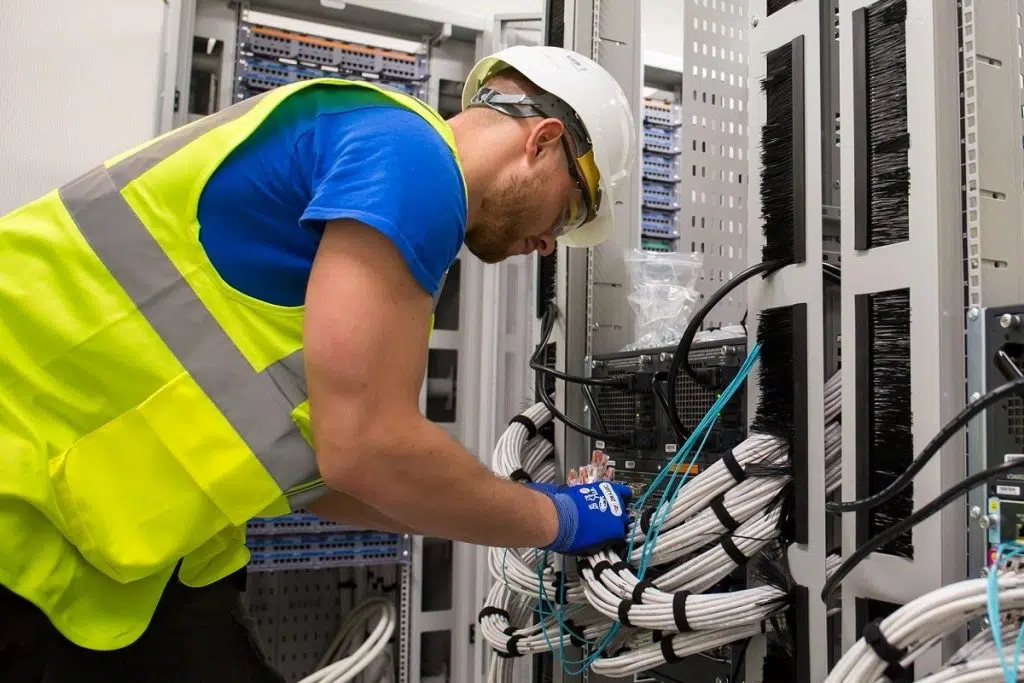In today’s fast-paced commercial construction landscape, structured cabling plays a pivotal role in creating smarter, more efficient building designs. A structured cabling system provides a comprehensive network of cables and associated hardware, forming the backbone of a building’s telecommunications infrastructure.
This robust system supports multiple applications, including voice, data, and video, ensuring seamless connectivity and optimal performance. In this guide, we will delve into the significance of structured cabling in commercial construction, exploring its components, benefits, standards, and best practices. By understanding the critical role of structured cabling, building owners and managers can ensure a reliable and scalable infrastructure that meets their current and future needs.
Understanding Structured Cabling Systems
What is a Structured Cabling System?
A structured cabling system is a standardized architecture of cables and associated hardware designed to provide a flexible and scalable infrastructure for commercial buildings. It supports various applications such as voice, data, video, and security systems, making it essential for modern business operations.
Structured cabling ensures that a building’s network infrastructure is organized, efficient, and capable of handling high-speed data transmission. Its significance in commercial buildings lies in its ability to integrate different systems, enhance network reliability, and accommodate future technological advancements.
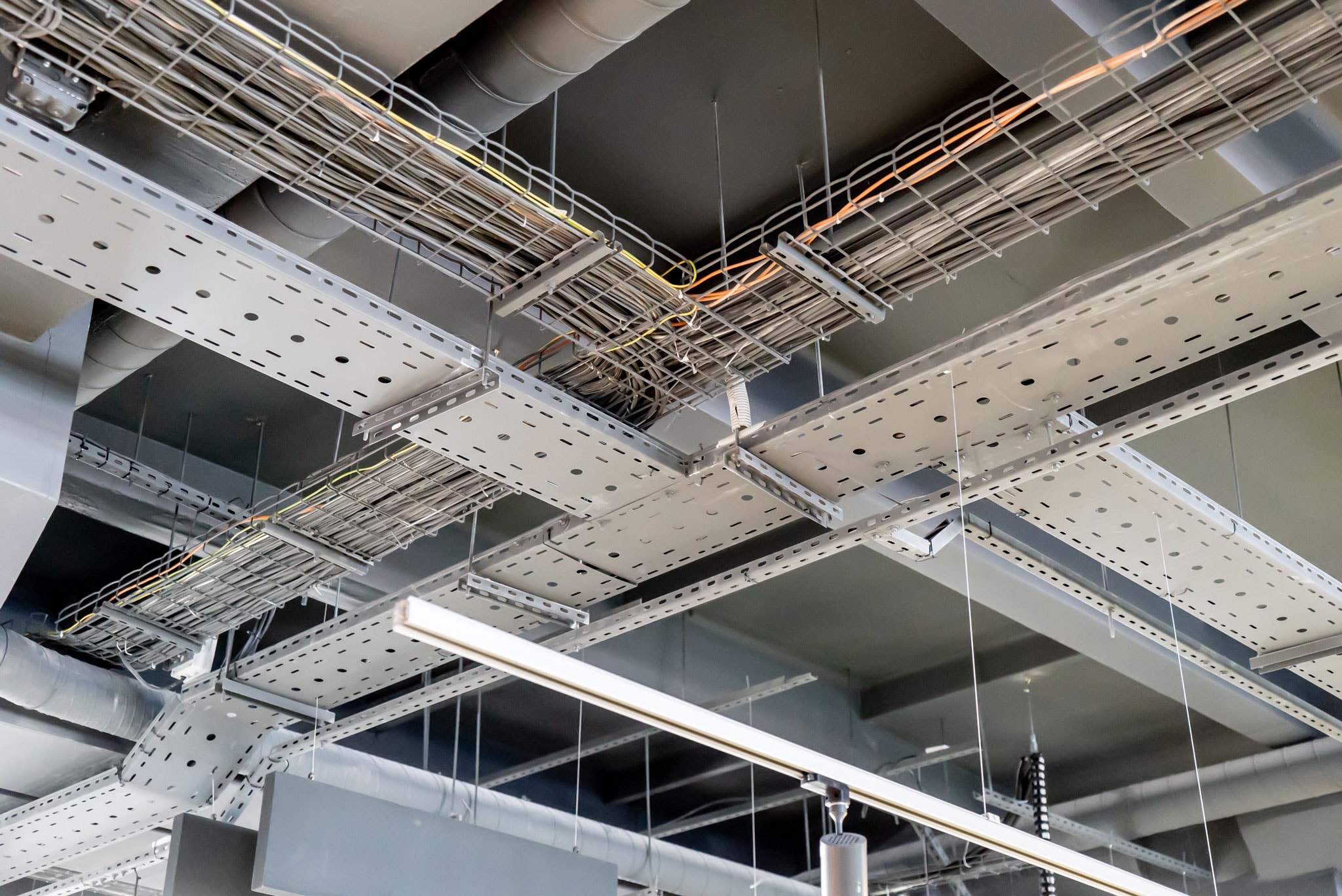
Components of Structured Cabling Systems
Structured cabling systems are composed of six key subsystems that work together to create a cohesive infrastructure:
- Entrance Facility: This is where the cabling interfaces with the external service provider’s network, ensuring connectivity to the outside world.
- Backbone Cabling: This subsystem provides interconnections between equipment rooms, telecommunications rooms, and entrance facilities within the building.
- Horizontal Cabling: This includes the cabling from telecommunications rooms to individual work areas, supporting end-user devices.
- Work Area: The work area encompasses all the components, including telecommunication outlets and patch cords, that connect end-user equipment to the network.
- Telecommunications Enclosure: This area houses the network equipment and connecting hardware.
- Consolidation Point: A point where multiple cables are interconnected, facilitating efficient cable management and future scalability.
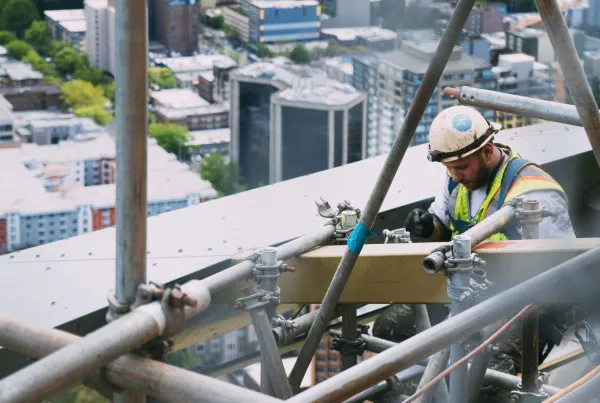
These components collectively ensure a reliable and efficient cabling infrastructure, providing the necessary foundation for a building’s telecommunications needs.
Benefits of Structured Cabling
Scalability and Flexibility
Structured cabling systems are designed with scalability and flexibility in mind, making them adaptable to the ever-changing technology landscape and business needs. These systems support a wide range of applications, including voice, data, video, and security system cabling, providing a unified infrastructure that can handle various services.
As businesses grow and technology evolves, structured cabling allows for easy upgrades and expansions without significant disruptions, ensuring the network remains robust and capable of meeting future demands.
Cost-Effectiveness and Efficiency
One of the primary benefits of structured cabling is its cost-effectiveness and efficiency. By implementing a structured cabling system, businesses can minimize the need for costly re-cabling as the organization grows or technology changes.
This reduces downtime and ensures continuous operation, which is crucial for maintaining productivity. Additionally, the organized nature of structured cabling simplifies maintenance and troubleshooting, further lowering operational costs and improving overall efficiency.
Structured Cabling Standards and Best Practices
ANSI/TIA-568 Standard: The Cornerstone of Structured Cabling
The ANSI/TIA-568 standard is a critical framework for the design, installation, and management of commercial building telecommunications cabling systems. This standard outlines specifications for cable types, connectors, and wiring configurations, ensuring consistency and interoperability across different systems and equipment.
Adhering to the ANSI/TIA-568 standard helps data cabling contractors and structured cabling installers achieve optimal performance and reliability in their network infrastructure. By following these guidelines, businesses can ensure that their cabling systems are robust, scalable, and capable of supporting high-speed data transmission, which is essential for modern commercial operations.
Industry Best Practices for Structured Cabling Installation
Implementing structured cabling requires adherence to industry best practices to ensure a reliable and efficient system. Key practices include following the ANSI/TIA-568 standard, using high-quality materials and equipment, and carefully planning for future growth and scalability. Vertical cabling and backbone cabling should be meticulously planned and executed to support reliable data transmission across the building.
Engaging a reliable structured cabling contractor with experience and expertise in structured cabling design and installation is crucial for a successful implementation. By incorporating these best practices, businesses can create a robust and adaptable cabling infrastructure that meets their current and future needs, enhancing overall network performance and reliability.
The Importance of a Well-Designed Structured Cabling System
Enhancing Network Reliability and Performance
A well-designed structured cabling system is essential for ensuring optimal performance and network reliability in commercial buildings. By providing a robust and organized infrastructure, structured cabling systems enable seamless connectivity and high-speed data transmission across various applications.
This organized approach reduces the likelihood of network failures and enhances the overall performance of the telecommunications infrastructure. The structured nature of these cabling systems also facilitates easier troubleshooting and maintenance, further contributing to network reliability and consistent performance.
Reducing Costs and Improving Efficiency
Investing in a well-designed structured cabling system offers significant cost savings and efficiency improvements over time. By minimizing the need for frequent and costly re-cabling, businesses can reduce downtime and maintenance costs.
A structured cabling system is also easier to manage and maintain, leading to quicker resolutions of network issues and lower operational expenses. The long-term benefits of such a system include improved productivity, reduced disruptions, and the ability to easily scale and adapt to future technological advancements, making it a smart investment for any commercial construction project.
The Role of Structured Cabling Specialists
Expertise in Design and Installation
Structured cabling specialists play a crucial role in the successful implementation of cabling systems in commercial construction. Their expertise in structured cabling design and installation ensures that the cabling infrastructure meets the specific needs of the building and its occupants.
Specialists assess the building’s requirements, plan the layout, select appropriate materials, and oversee the installation process to guarantee a robust and efficient system. Their knowledge of industry standards, such as the ANSI/TIA-568 standard, and best practices ensures that the cabling system is reliable, scalable, and capable of supporting future technological advancements.
By leveraging the skills of structured cabling specialists, businesses can achieve a high-quality cabling infrastructure that enhances overall network performance and reliability.
Ongoing Maintenance and Support
Continuous maintenance and support are vital for keeping a structured cabling system functioning optimally. Structured cabling specialists provide ongoing services to ensure the system remains in good condition and adapts to any changes in technology or business needs. Regular inspections, testing, and updates help identify and resolve potential issues before they cause significant disruptions.
Specialists also offer support for troubleshooting and repairs, ensuring minimal downtime and maintaining the efficiency of the network. By partnering with experienced structured cabling specialists for ongoing maintenance, businesses can ensure the longevity and reliability of their cabling infrastructure, ultimately supporting smooth and uninterrupted operations.
Choosing the Right Structured Cabling Installer
Key Considerations
Selecting the right structured cabling installer is crucial for a successful cabling installation project. Key considerations include the installer’s experience and expertise in designing and installing cabling systems. An experienced installer will be familiar with industry standards, such as the ANSI/TIA-568 standard, and best practices, ensuring that the installation meets high-quality and performance criteria.
Additionally, a good installer will be knowledgeable about the latest technologies and capable of planning for future growth, ensuring that the system remains scalable and adaptable to evolving business needs.
Reputation and Customer Service
The reputation and customer service of a structured cabling installer are equally important. A reputable installer will have a proven track record of successful projects and satisfied clients. It’s essential to research and seek recommendations to find an installer with a strong reputation in the industry.
Excellent customer service is also critical, as it ensures that the installer will be responsive to your needs and provide ongoing support. An installer who values customer satisfaction will go the extra mile to ensure a smooth installation process and long-term reliability of the cabling system.
Structured Cabling Installation Considerations
Selecting Cabling Materials and Equipment
Choosing high-quality cabling materials and equipment is fundamental to the success of a structured cabling installation. High-quality materials ensure reliability and efficiency, reducing the risk of network failures and the need for frequent maintenance.
It’s important to select cables, connectors, and other components that meet industry standards and are compatible with the overall system design. Investing in quality materials upfront can prevent costly issues and ensure a robust and efficient cabling infrastructure.
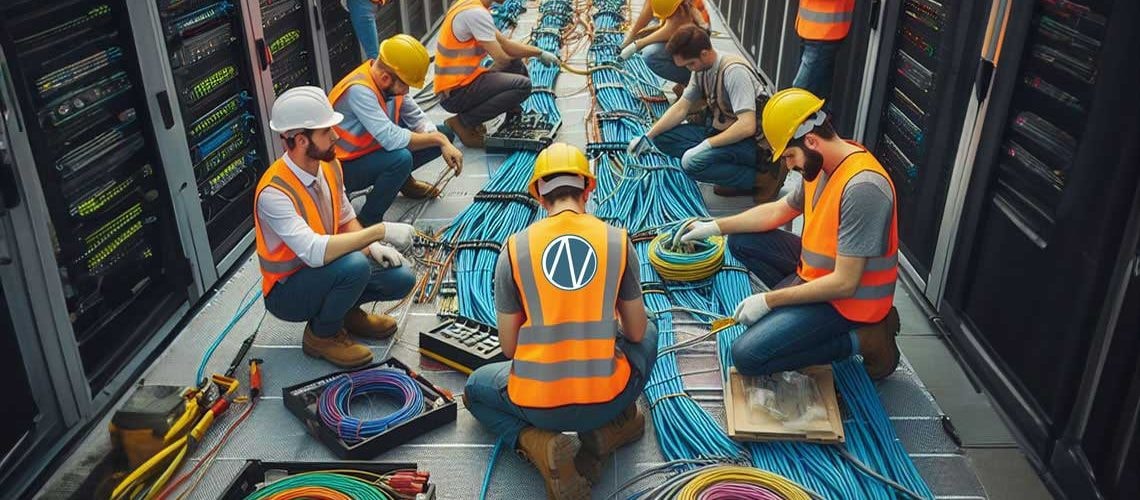
Designing for Future Growth
Planning for future growth and scalability is a critical consideration in structured cabling design. A well-thought-out design allows for easy expansion and adaptation as business needs change and technology evolves.
By anticipating future requirements, businesses can reduce future costs associated with re-cabling and system upgrades. Scalable designs also enhance the flexibility of the network, enabling seamless integration of new technologies and applications without major disruptions.
Private Network Cabling Systems
In certain cases, private network cabling systems may be necessary to ensure security and reliability for sensitive applications. These systems provide dedicated pathways for critical data, enhancing network performance and safeguarding information. Properly designed and installed private network cabling systems can significantly improve the overall security and efficiency of a commercial building’s telecommunications infrastructure.
Cable Management for Accessibility and Maintenance
Labeling and Organization
Proper labeling and organization of cables are crucial for effective cable management in structured cabling systems. Labeling each cable accurately facilitates easy identification and access, making maintenance and troubleshooting more efficient.
Well-organized cables reduce the risk of errors during modifications and ensure that technicians can quickly locate and address any issues. Effective cable organization also contributes to a cleaner and more professional-looking installation, enhancing the overall reliability and performance of the cabling infrastructure.
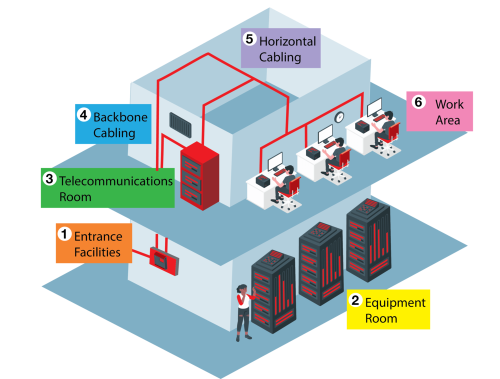
Patch Panels and Consolidation Points
Patch panels and consolidation points are essential components in simplifying cable management. Patch panels provide a central point for connecting and disconnecting cables, streamlining network changes and maintenance tasks. Consolidation points help manage multiple cables in a single location, reducing clutter and improving organization.
The benefits of well-organized cabling systems include easier scalability, reduced downtime, and enhanced system reliability. By incorporating patch panels and consolidation points, businesses can ensure their structured cabling systems remain accessible, efficient, and adaptable to future needs.
The Future of Structured Cabling
Emerging Technologies and Trends
The future of structured cabling will be significantly influenced by emerging technologies and trends. As new technologies such as 5G, IoT, and advanced security systems become more prevalent, the demand for robust and adaptable structured cabling systems will increase. Security system cabling and horizontal cabling will play increasingly important roles in supporting these advancements.
Additionally, the shift towards high-speed data transmission and greater connectivity will drive the adoption of fiber optic cabling and other high-performance cabling solutions, ensuring that networks can handle growing data demands.
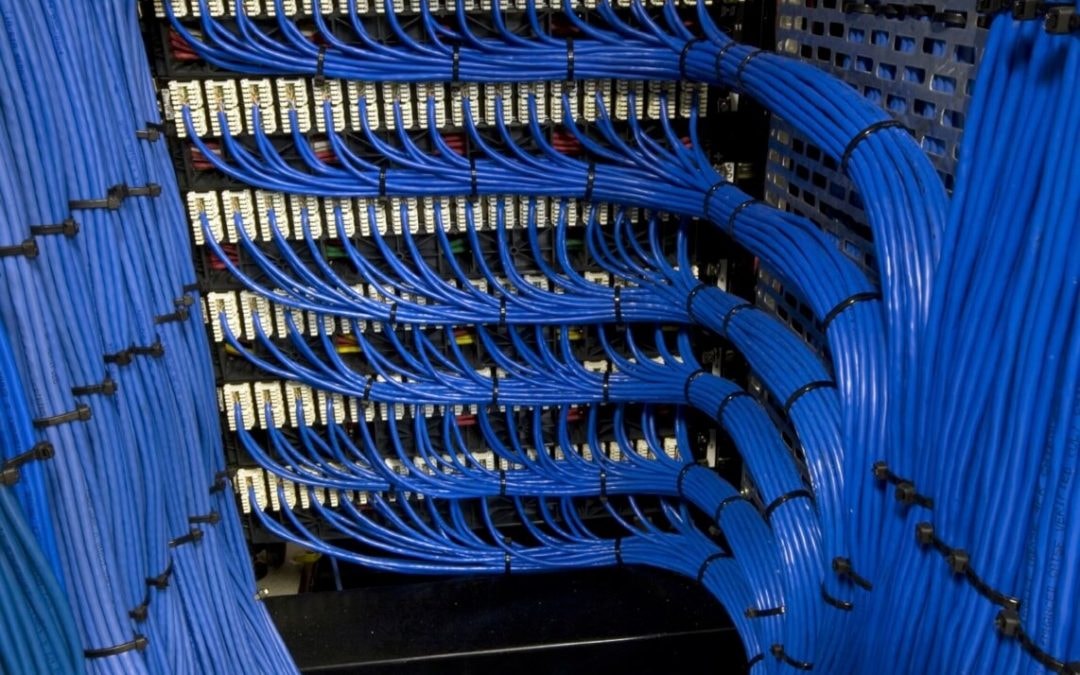
Evolution of Standards and Practices
Structured cabling standards and best practices will continue to evolve to accommodate new technologies and industry requirements. The ANSI/TIA-568 standard and other guidelines will be updated to reflect advancements in cabling materials, installation techniques, and performance criteria.
Future-proofing structured cabling systems will involve designing with flexibility and scalability in mind, allowing for seamless integration of new technologies. By staying abreast of evolving standards and best practices, businesses can ensure their cabling infrastructure remains efficient, reliable, and capable of supporting future growth and technological advancements.

